

American Old West. Gunfight At The OK Corral - Tombstone - Wyatt Earp, Doc Holliday - Ike Clanton. What Hollywood never told you, this is what really happened!
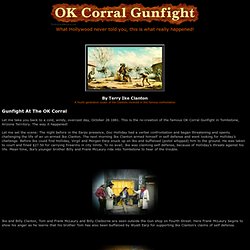
By Terry Ike ClantonA fourth generation cousin of the Clantons involved in this famous confrontation Gunfight At The OK Corral Let me take you back to a cold, windy, overcast day, October 26 1881. This is the re-creation of the famous OK Corral Gunfight in Tombstone, Arizona Territory. The way it happened! Let me set the scene: The night before in the Earps presence, Doc Holliday had a verbal confrontation and began threatening and openly challenging the life of an un-armed Ike Clanton. Ike and Billy Clanton, Tom and Frank McLaury and Billy Claiborne are seen outside the Gun shop on Fourth Street. Meanwhile, the Earps brothers (Wyatt, Morgan and Virgil) are joined in Haffords Saloon by J.H. The cowboys gather in a vacant lot behind the OK Corral, between Flys Photo Studio and the Harwood house.
Sheriff Johnny Behan heads down Fremont Street towards the vacant lot where the Cowboys have gathered. Belle Starr. Myra Maybelle Shirley Reed Starr (February 5, 1848 – February 3, 1889), better known as Belle Starr, was a notorious American outlaw.
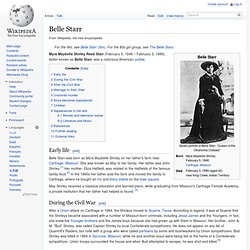
Early life[edit] Belle Starr was born as Myra Maybelle Shirley on her father's farm near Carthage, Missouri. She was known as May to her family. Wild Bill Hickok. James Butler Hickok (May 27, 1837 – August 2, 1876)—known as "Wild Bill" Hickok—was a folk character of the American Old West.
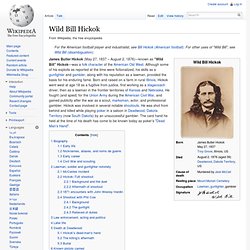
Although some of his exploits as reported at the time were fictionalized, his skills as a gunfighter and gambler, along with his reputation as a lawman, provided the basis for his enduring fame. Born and raised on a farm in rural Illinois, Hickok went west at age 18 as a fugitive from justice, first working as a stagecoach driver, then as a lawman in the frontier territories of Kansas and Nebraska. He fought (and spied) for the Union Army during the American Civil War, and gained publicity after the war as a scout, marksman, actor, and professional gambler. Hickok was involved in several notable shootouts. He was shot from behind and killed while playing poker in a saloon in Deadwood, Dakota Territory (now South Dakota) by an unsuccessful gambler.
Biography[edit] Early life[edit] Jesse James. Jesse Woodson James (September 5, 1847 – April 3, 1882) was an American outlaw, gang leader, bank robber, train robber, and murderer from the state of Missouri and the most famous member of the James-Younger Gang.
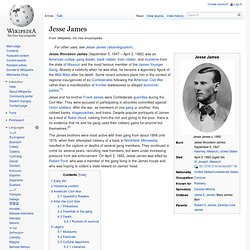
Already a celebrity when he was alive, he became a legendary figure of the Wild West after his death. Some recent scholars place him in the context of regional insurgencies of ex-Confederates following the American Civil War rather than a manifestation of frontier lawlessness or alleged economic justice.[1] Jesse and his brother Frank James were Confederate guerrillas during the Civil War. They were accused of participating in atrocities committed against Union soldiers. Wyatt Earp. After leaving Tombstone, Earp and his third wife Josephine Earp moved from one boomtown to another, starting in Eagle City, Idaho; followed by San Diego, California; Nome, Alaska; Tonopah, Nevada; and finally Vidal, California.
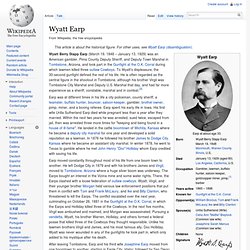
An extremely flattering, largely fictionalized, best-selling biography published after his death created his reputation as a fearless lawman. As a result of the book, Wyatt Earp has been the subject of and model for a large number of films, TV shows, biographies and works of fiction that have increased his mystique. Earp's modern-day reputation is that of the Old West's "toughest and deadliest gunman of his day".[3] Until the book was published, Earp had a dubious reputation as a minor figure in Western history.
In modern times, Wyatt Earp has become synonymous of the stereotypical image of a lawman, and is a symbol of American frontier justice.[4] Early life[edit] Wyatt Earp with his mother Virginia Ann Cooksey Earp c. 1856. Earp's boyhood home in Pella. Billy the Kid. William H.
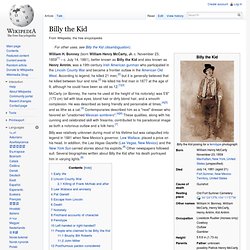
Bonney (born William Henry McCarty, Jr. c. November 23, 1859[1] – c. July 14, 1881), better known as Billy the Kid and also known as Henry Antrim, was a 19th-century Irish American gunman who participated in the Lincoln County War and became a frontier outlaw in the American Old West. According to legend, he killed 21 men,[2] but it is generally believed that he killed between four and nine.[2] He killed his first man in 1877 at the age of 9, although he could have been as old as 12.[1][3] McCarty (or Bonney, the name he used at the height of his notoriety) was 5'8" (173 cm) tall with blue eyes, blond hair or dirty blond hair, and a smooth complexion. Early life[edit] William Henry McCarty, Jr. is believed by Michael Wallis and Robert M.
At the age of 14, McCarty was taken in by a neighboring family who operated a hotel. He was forced to seek new lodgings when his foster family began to experience domestic problems. During this time, McCarty became acquainted with John R. Morgan Earp. Virgil was gravely wounded in an ambush on December 28, 1881, and Morgan was assassinated on March 18, 1882 by a shot through the window of a door while he was playing billiards.
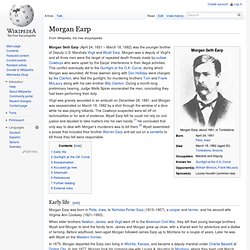
The Cowboys suspected were let off on technicalities or for lack of evidence. Wyatt Earp felt he could not rely on civil justice and decided to take matters into his own hands.[1] He concluded that only way to deal with Morgan's murderers was to kill them.[2] Wyatt assembled a posse that included their brother Warren Earp and set out on a vendetta to kill those they felt were responsible. Early life[edit] Doc Holliday. John Henry "Doc" Holliday (August 14, 1851 – November 8, 1887) was an American gambler, gunfighter, and dentist of the American Old West who is usually remembered for his friendship with Wyatt Earp and his involvement in the Gunfight at the O.K.

Corral. As a young man, Holliday earned a D.D.S. degree from the Pennsylvania College of Dental Surgery and set up a dental practice in Atlanta, Georgia. In 1873 he was diagnosed with tuberculosis, the same disease that had claimed his mother when he was 15. He moved to the American Southwest in hopes that the climate would prolong his life. Lewis and Clark Expedition. The Lewis and Clark Expedition, also known as the Corps of Discovery Expedition, was the first American expedition to cross what is now the western portion of the United States, departing in May, 1804, from near St.
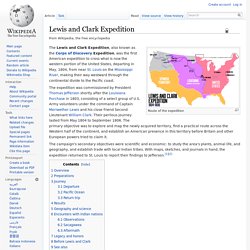
Louis on the Mississippi River, making their way westward through the continental divide to the Pacific coast. The campaign's secondary objectives were scientific and economic: to study the area's plants, animal life, and geography, and establish trade with local Indian tribes. With maps, sketches, and journals in hand, the expedition returned to St. Louis to report their findings to Jefferson.[1][2] Overview According to Jefferson himself, one goal was to find "the most direct and practicable water communication across this continent, for the purposes of commerce. " Although the expedition did make notable contributions to science,[7] scientific research itself was not the main goal of the mission.[8] Preparations The historian John L. Journey Departure Pacific Ocean Return trip.